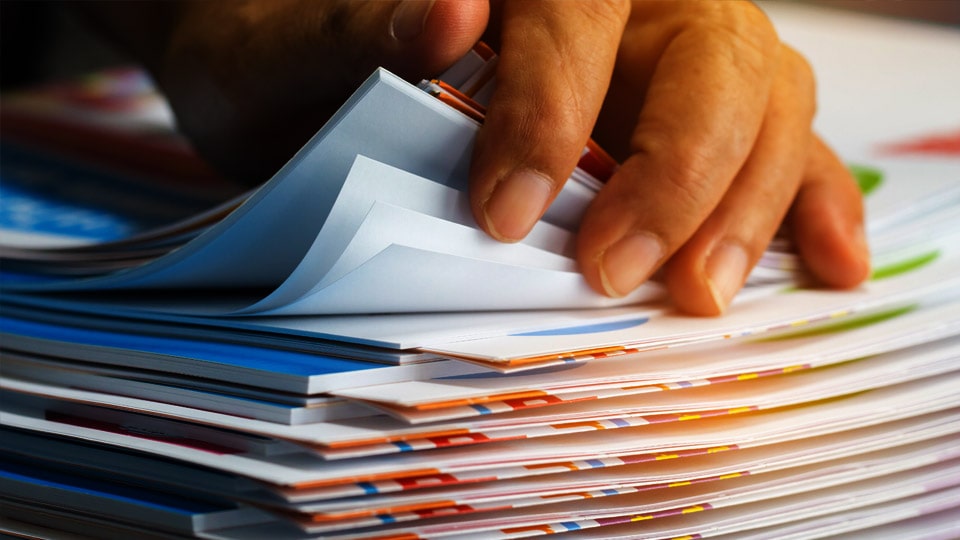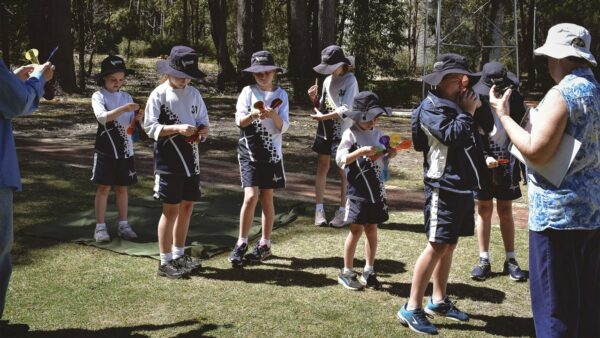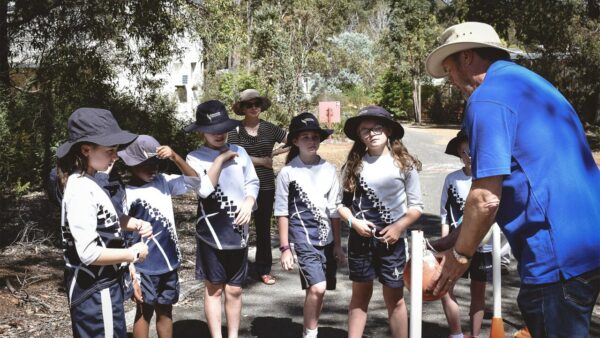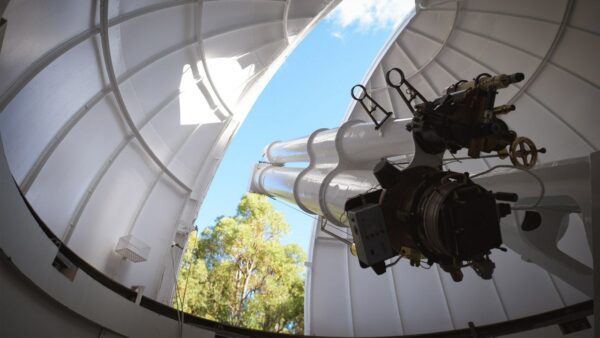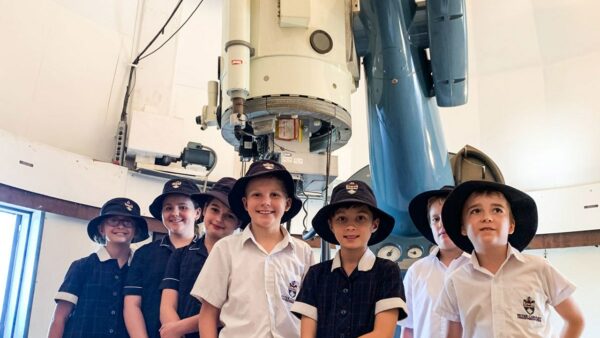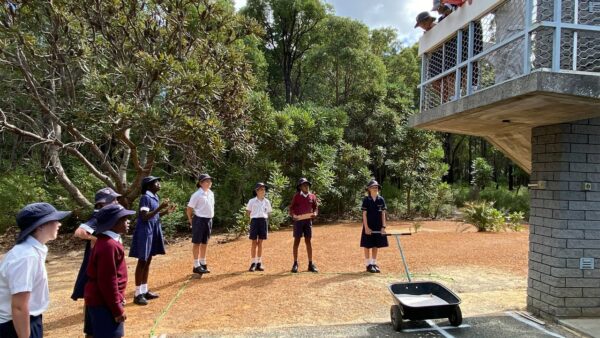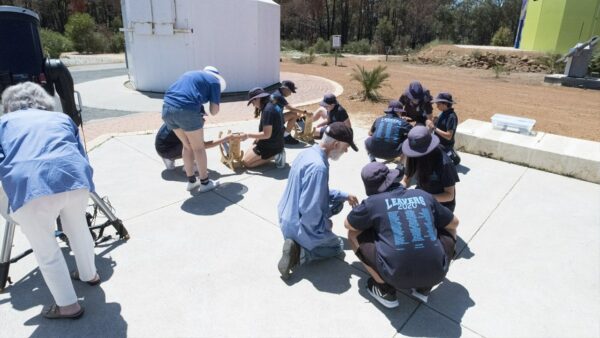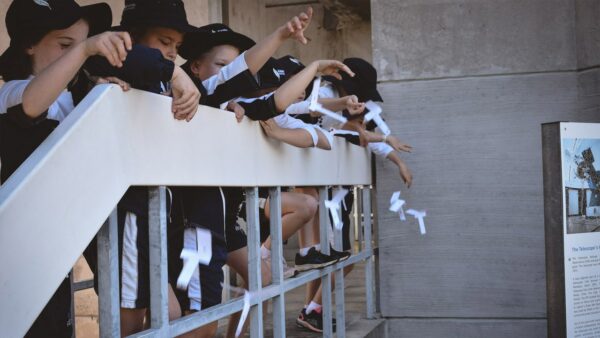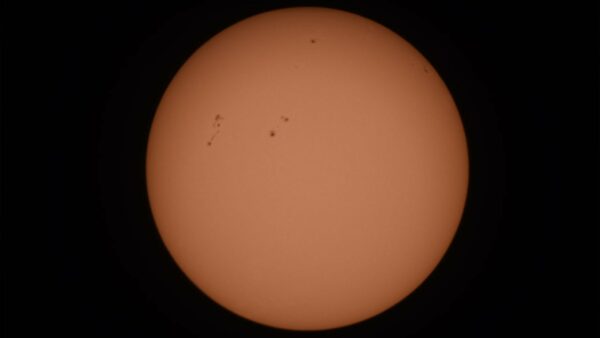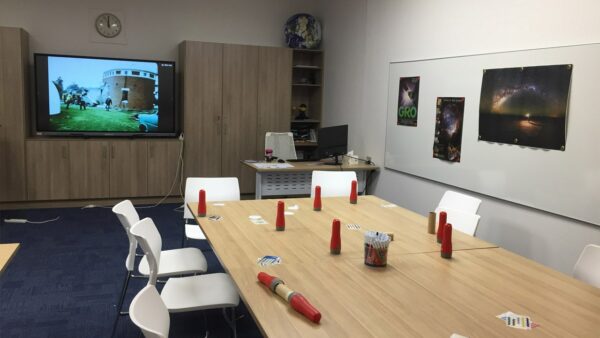Our fees are based on the number of activities:
$12 per student – 4 Activities
$14 per student – 5 Activities
$14 per student – OSHC Tours (4 Activities for each of three age groups)
The time of arrival and departure for School Day Tours will be confirmed when your booking is confirmed.
We are thrilled to offer a variety of exciting and educational experiences for primary school students and children of all ages.
Our primary school day tours are specifically designed for students in Years 2 to 6, offering a range of activities that are aligned with the Australian Curriculum. These activities take place on the grounds and inside the buildings of our Observatory, where students can learn more about astronomy and physics while exploring our collection of modern and historical telescopes. By participating in our tours, students will have the opportunity to expand their knowledge and gain a deeper appreciation for the wonders of the universe.
Home Schooling Groups
We do cater for home-schooling groups. Please note that the year level range is from year 2 to year 6. We do not cater for any students younger or older than this. Siblings outside the age range may come along, but they will need to stay with their parents or carers as they move around with the groups.
OSHC Tours
Our Out of School Holiday Care tours are specially designed for children aged 4 to 12 years, offering a fun and educational experience that inspires curiosity about space and science.
Each tour features four hands-on activities that blend discovery and play, helping children learn and explore in a safe, inclusive, and supportive environment. Activities are thoughtfully tailored to three age groups: 4–6, 7–9, and 10–12 years, ensuring every child is engaged, challenged, and having a great time.
Tours run from 10:00 am to 1:30 pm, with a short break for morning tea. To ensure an enjoyable and safe visit, we ask that no more than three adults accompany each group when inside telescope domes or activity rooms.
Please note: All volunteers at Perth Observatory must hold a current and valid Working with Children Check (WWCC). This is both a legal requirement and a condition of volunteering with the Perth Observatory Volunteer Group (POVG)
Maximum Group Size
School Day Tour Size
The maximum number of students we can accommodate for School Day Tours or Home School visits is 60. For groups between 50 and 60 students, we require five activities to be selected to ensure the group can be managed effectively. The minimum group size is 20 students, unless otherwise approved by the School Day Tours Subcommittee. Please contact us if you would like to discuss your group’s needs or special circumstances.
Out of School Holiday Care Tour Size
For Out-of-School Holiday Care (OSHC) visits, the maximum number of students we can accommodate is 40. The minimum group size is 20 students, unless otherwise approved by the School Day Tours Subcommittee.
Each group may be accompanied by up to three adults due to space limitations. Any additional adults will be charged as extras.
If you are interested in arranging a tour for a year level not listed, or if your group exceeds 60 students (school tours) or 40 students (OSHC tours), please contact us so we can discuss possible options to accommodate your needs.

Maximum Group Size
School Day Tour Activities
Year 2 Day Tour Activities
Year 2 teachers can choose between 2 options:
- Option 1: Stella’s Telescope Quest and 3 other activities.
- Option 2: Stella’s Telescope Quest and 4 other activities.
Stella’s Telescope Quest
Join Stella, a curious little girl who has misplaced her spaceship somewhere in the Observatory. As she visits each telescope in search of her missing craft, students follow along on her adventure, discovering what each telescope does and how it helps us explore the night sky. This fun, hands-on activity encourages curiosity, teamwork, and a deeper understanding of how astronomers use different tools to unlock the secrets of space.
ES1. Cosmic Dance
Students take part in a fun, active role play to explore how the Sun, Earth, and Moon move and interact, learning about orbit and rotation through movement and play.
ES2. It’s Just a Phase
Students explore the Moon’s phases and its effects on Earth through interactive learning. They’ll model their knowledge of the phases using biscuits and take home a Moon diary to continue their observations.
ES3. What Planet is that?
Students explore the solar system, learning the order of the planets and a mnemonic to remember them. They’ll discover fun facts about each planet and create their own scale model of the solar system.
ES4. Shadow, Shadow on the Wall
Weather permitting – students look at shadows and how they change as the sun appears to move across the sky. They examine the observatory sundial and then make a sundial of their own, which they can use and compare to the time on the Observatory sundial and then take back to school.
ES5. First Nations Astronomy
Coming soon
Year 3/4 Day Tour Activities
Year 3/4 teachers can choose between 2 options:
- Option 1: 4 activities
- Option 2: 5 activities
M1. Meteorites and the Moon
The students see the (very large) piece of a meteorite in the Observatory Museum, with a discussion covering the history of the meteorite and the most common origins of meteorites. The students then engage in activities demonstrating the moon phases and why we see them.
M2. Our Solar System
Students will look at the order of the planets in the solar system along a scaled route. This will be followed by an extension activity related to the Solar System.
M3. Sun, Earth and Moon
This activity compares the sizes of the Sun, Earth and Moon and then engages the students in role play to show how the Sun, Moon and Earth interact. An introductory look at the planets is also included, with a mnemonic to help remember the order of the planets.
M4. Lowell Telescope 1
This was the main research telescope at the observatory. Students will learn about some aspects of astronomical research and how the telescope works. They will then engage in an activity linking to helicopters on Mars.
M7. Shadows and Sundials
Weather permitting – students look at shadows and how they change as the sun appears to move across the sky. They examine the observatory sundial and then make a sundial of their own, which they can use and compare to the time on the Observatory sundial and then take back to school.
M8. Sunshine and Rainbows
Students look for visible rainbows and then use special lenses to see rainbows everywhere. The reason for rainbows is discussed, and their link to astronomy. The students then have a look at objects through coloured filters to see what happens to the rainbows.
M10. Telescope Tour 1
This gives the students an opportunity to look at two or three of the Observatory’s old and more modern telescopes and learn a little bit about their history and what they were used for.
Year 5/6 Day Tour Activities
Year 5/6 teachers can choose between 2 options:
- Option 1: 4 activities
- Option 2: 5 activities
U1. Meteorites and More
The students see the (very large) piece of a meteorite in the Observatory Museum, with a discussion covering the history of the meteorite and the most common origins of meteorites. They then do activities that demonstrate moon phases, eclipses and why we only see one side of the moon. A model is then used to demonstrate why we have seasons.
U2. Solar Walk
This walk demonstrates the distances between the planets using a scale model, with facts about the planets presented as they walk. They then try to fit carded information to the right planet, discussing specific aspects of some planets, including the length of their days.
U3. Solar Rings
The students use teamwork to initially sort the planets into order on our solar rings diagram and then work out which orbital times belong to which planet. Students try to work out how old they would be on some of the planets based on the length of the planets’ orbits, and then have an opportunity to see how old they would be on each of the planets. They then engage in an activity that looks at the sizes of the planets and are given a mnemonic to remember the size order.
U4. Lowell Telescope 2
This was the main research telescope at the observatory. Students will learn about some aspects of astronomical research and how the telescope works. They will be involved in an investigation relating to gravity and craters.
U6. Solar Quest
Weather permitting, students get the opportunity to look at the sun in real time safely in two different ways. The first is using Sunspotters. These allow an image of the sun to be shown on a screen below eye level. At no stage does the student look at the sun. The second is using an Observatory telescope with a safe solar filter on it, and students look through the telescope at the sun. At all times, there is an emphasis on safely looking at the Sun, and students are instructed to never look at the Sun through any other telescope. They then engage in a discussion explaining some of the sun’s activities.
U8. Survival on the Moon
Learn a bit more about the moon and do a NASA-designed activity to see if you and your friends would survive a crash on the moon.
U10. Telescope Tour 2
This gives the students an opportunity to look at two or three of the Observatory’s old and more modern telescopes and learn a little bit about their history and what they were used for.
Please note: If the weather does not allow for outside activities, activities presenting similar concepts will take place inside the main building. However, if at all possible, some activities will take place in the domes so that students. Can see the telescopes. Perth Observatory reserves the right to change or adjust these activities as necessary.
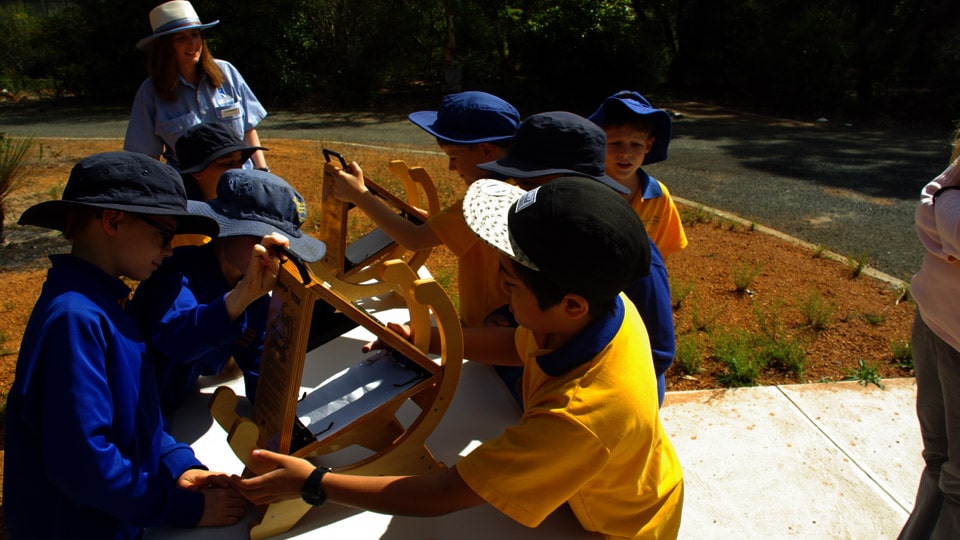
School Day Tour Activities
OSHC Tours Activities
The children will be split into groups by age. Each group has a separate set of activities suited to that age group.
Please note: School tour activities are not available during the school holidays.
Tour Activities For Kids 4-6 Years Old
A variety of activities around the themes of ‘The Colours of the Sun’, ‘Our Place in Space’ and ‘Domes and Fairy Doors’ will be chosen by the presenters to suit the groups.
Tour Activities For Kids 7-9 Years Old
7-9HC1. Deep Impact
The children are engaged in discussing and examining the Observatory meteorite and learning about craters. They watch a demonstration of how craters are made and then enjoy using objects to make craters.
7-9HC2. Make a Sundial
Students learn about the Observatory sundial and make their own paper sundial to take home.
7-9HC3. Constellation Capers
The children look at constellations either on a poster or on a screen and then make a ‘constellation wheel’ showing some of the constellations they have looked at.
7-9HC4. Who are our Neighbours
The children are introduced to the planets of our Solar System. They then reinforce their understanding of the order of the planets by making a planet wheel.
Tour Activities For Kids 10-12 Years Old
10-12HC1. Meteorites and More
The children will visit our museum and see and learn about our meteorite, which is usually very popular. Time permitting, other exhibits may be discussed and may extend into a demonstration and discussion of a simple orrery.
10-12HC2. Lowell Dome & Helicopters on Mars
Children climb the 69 steps to the top of the Lowell Dome, learn about the telescope and about Mars exploration. Then make and test a paper helicopter to take home.
10-12HC3. Constellation Capers
The children look at constellations either on a poster or on a screen and then make a ‘constellation wheel’ showing some of the constellations they have looked at.
10-12HC4. Telescope Tour
Children tour the Observatory’s old and new telescopes
Please note: If the weather does not allow for outside activities, activities presenting similar concepts will take place inside the main building. However, if at all possible, some activities will take place in the domes so that students can see the telescopes. Perth Observatory reserves the right to change or adjust these activities as necessary.
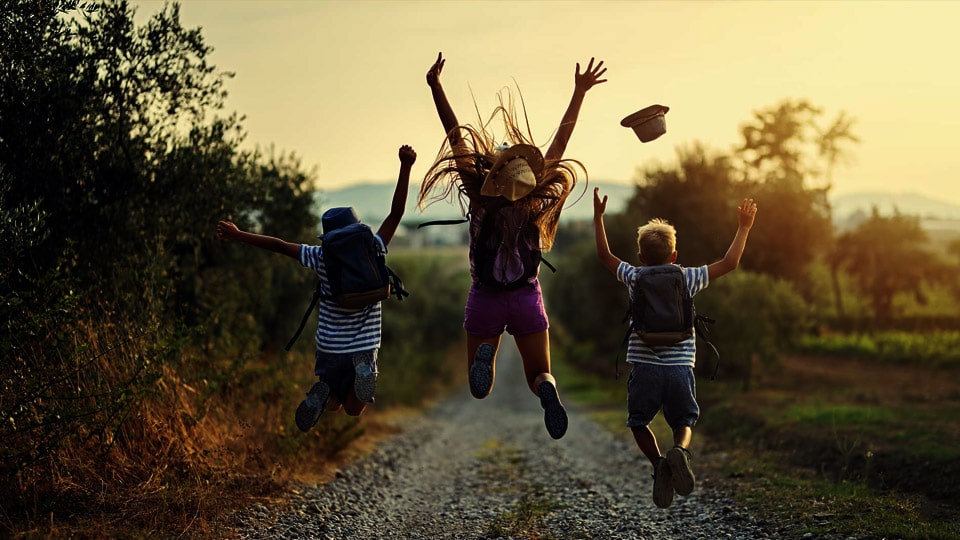
OSHC Tours Activities
Enquire Today
To help us plan your School Day Tour or OSHC Tour, please take a moment to complete the booking form below.
Each activity runs for 40 minutes, 30 minutes of learning time and 10 minutes for changeover between activities. Please refer to the Day Tour Activities section above and include your preferred activities on the booking form.
When planning your visit, please allow:
-
15–20 minutes at the start of the tour for student organisation and toilet breaks
-
30 minutes for recess
-
30 minutes for lunch
If you would like students to use Rainbow Glasses, an additional cost of $1.00 per student applies, and students may take the glasses home. Please note this on your booking form if you wish to include this option.
Once we receive your booking form, we will contact you during business hours to assist with finalising your visit.
Please note: Please refer to the maximum group sizes before booking


